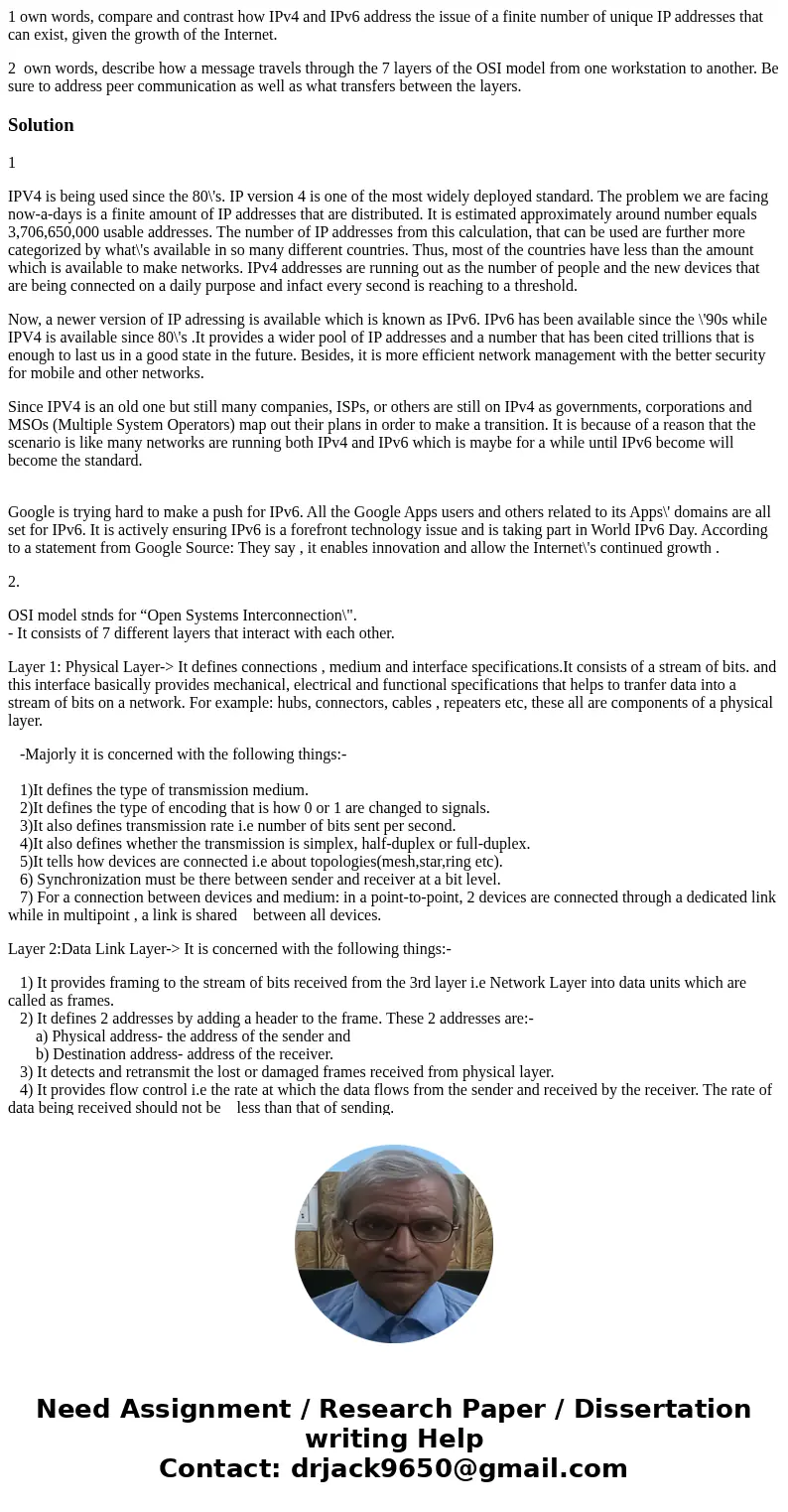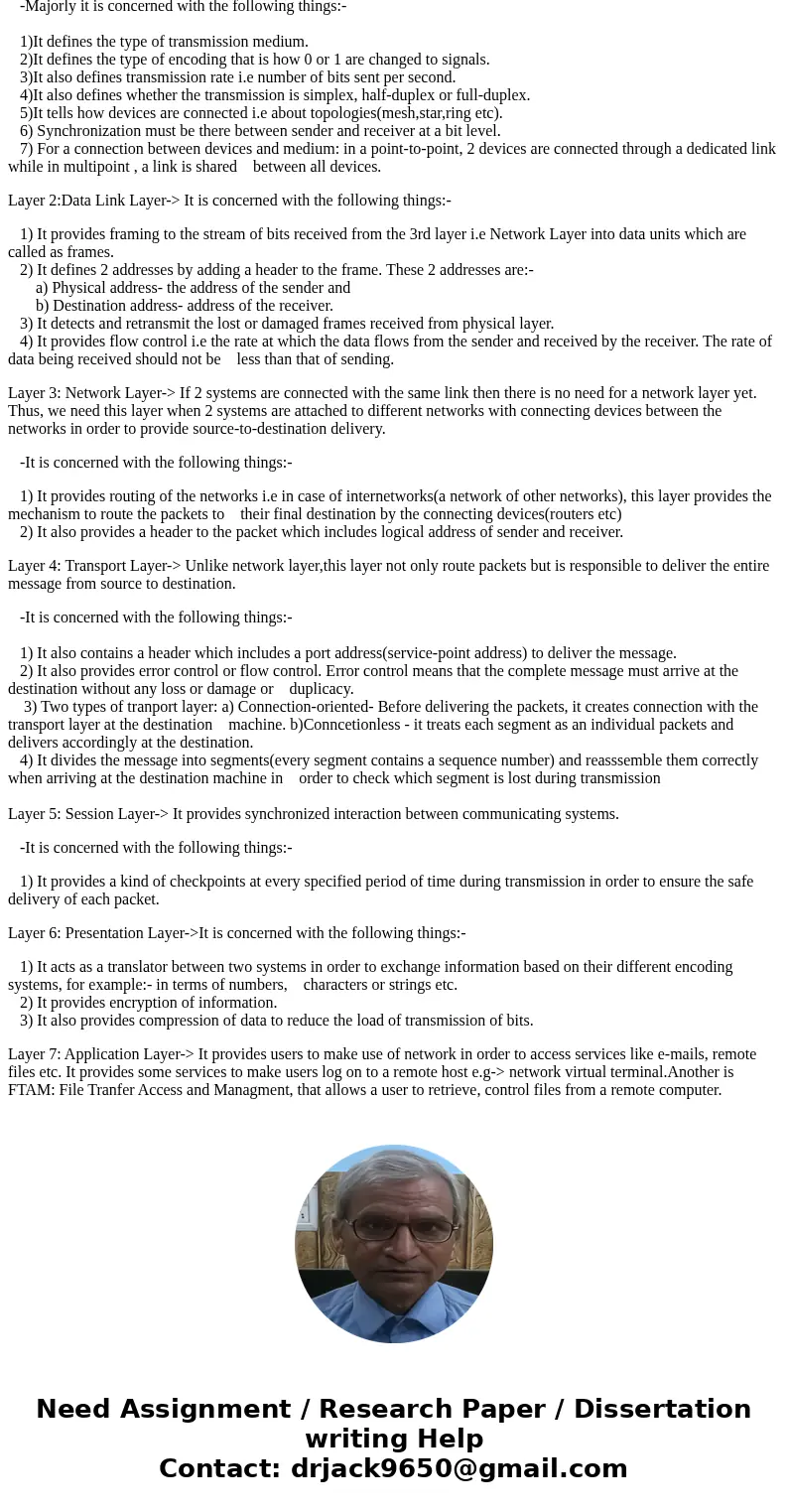1 own words compare and contrast how IPv4 and IPv6 address t
1 own words, compare and contrast how IPv4 and IPv6 address the issue of a finite number of unique IP addresses that can exist, given the growth of the Internet.
2 own words, describe how a message travels through the 7 layers of the OSI model from one workstation to another. Be sure to address peer communication as well as what transfers between the layers.
Solution
1
IPV4 is being used since the 80\'s. IP version 4 is one of the most widely deployed standard. The problem we are facing now-a-days is a finite amount of IP addresses that are distributed. It is estimated approximately around number equals 3,706,650,000 usable addresses. The number of IP addresses from this calculation, that can be used are further more categorized by what\'s available in so many different countries. Thus, most of the countries have less than the amount which is available to make networks. IPv4 addresses are running out as the number of people and the new devices that are being connected on a daily purpose and infact every second is reaching to a threshold.
Now, a newer version of IP adressing is available which is known as IPv6. IPv6 has been available since the \'90s while IPV4 is available since 80\'s .It provides a wider pool of IP addresses and a number that has been cited trillions that is enough to last us in a good state in the future. Besides, it is more efficient network management with the better security for mobile and other networks.
Since IPV4 is an old one but still many companies, ISPs, or others are still on IPv4 as governments, corporations and MSOs (Multiple System Operators) map out their plans in order to make a transition. It is because of a reason that the scenario is like many networks are running both IPv4 and IPv6 which is maybe for a while until IPv6 become will become the standard.
Google is trying hard to make a push for IPv6. All the Google Apps users and others related to its Apps\' domains are all set for IPv6. It is actively ensuring IPv6 is a forefront technology issue and is taking part in World IPv6 Day. According to a statement from Google Source: They say , it enables innovation and allow the Internet\'s continued growth .
2.
OSI model stnds for “Open Systems Interconnection\".
- It consists of 7 different layers that interact with each other.
Layer 1: Physical Layer-> It defines connections , medium and interface specifications.It consists of a stream of bits. and this interface basically provides mechanical, electrical and functional specifications that helps to tranfer data into a stream of bits on a network. For example: hubs, connectors, cables , repeaters etc, these all are components of a physical layer.
-Majorly it is concerned with the following things:-
1)It defines the type of transmission medium.
2)It defines the type of encoding that is how 0 or 1 are changed to signals.
3)It also defines transmission rate i.e number of bits sent per second.
4)It also defines whether the transmission is simplex, half-duplex or full-duplex.
5)It tells how devices are connected i.e about topologies(mesh,star,ring etc).
6) Synchronization must be there between sender and receiver at a bit level.
7) For a connection between devices and medium: in a point-to-point, 2 devices are connected through a dedicated link while in multipoint , a link is shared between all devices.
Layer 2:Data Link Layer-> It is concerned with the following things:-
1) It provides framing to the stream of bits received from the 3rd layer i.e Network Layer into data units which are called as frames.
2) It defines 2 addresses by adding a header to the frame. These 2 addresses are:-
a) Physical address- the address of the sender and
b) Destination address- address of the receiver.
3) It detects and retransmit the lost or damaged frames received from physical layer.
4) It provides flow control i.e the rate at which the data flows from the sender and received by the receiver. The rate of data being received should not be less than that of sending.
Layer 3: Network Layer-> If 2 systems are connected with the same link then there is no need for a network layer yet. Thus, we need this layer when 2 systems are attached to different networks with connecting devices between the networks in order to provide source-to-destination delivery.
-It is concerned with the following things:-
1) It provides routing of the networks i.e in case of internetworks(a network of other networks), this layer provides the mechanism to route the packets to their final destination by the connecting devices(routers etc)
2) It also provides a header to the packet which includes logical address of sender and receiver.
Layer 4: Transport Layer-> Unlike network layer,this layer not only route packets but is responsible to deliver the entire message from source to destination.
-It is concerned with the following things:-
1) It also contains a header which includes a port address(service-point address) to deliver the message.
2) It also provides error control or flow control. Error control means that the complete message must arrive at the destination without any loss or damage or duplicacy.
3) Two types of tranport layer: a) Connection-oriented- Before delivering the packets, it creates connection with the transport layer at the destination machine. b)Conncetionless - it treats each segment as an individual packets and delivers accordingly at the destination.
4) It divides the message into segments(every segment contains a sequence number) and reasssemble them correctly when arriving at the destination machine in order to check which segment is lost during transmission
Layer 5: Session Layer-> It provides synchronized interaction between communicating systems.
-It is concerned with the following things:-
1) It provides a kind of checkpoints at every specified period of time during transmission in order to ensure the safe delivery of each packet.
Layer 6: Presentation Layer->It is concerned with the following things:-
1) It acts as a translator between two systems in order to exchange information based on their different encoding systems, for example:- in terms of numbers, characters or strings etc.
2) It provides encryption of information.
3) It also provides compression of data to reduce the load of transmission of bits.
Layer 7: Application Layer-> It provides users to make use of network in order to access services like e-mails, remote files etc. It provides some services to make users log on to a remote host e.g-> network virtual terminal.Another is FTAM: File Tranfer Access and Managment, that allows a user to retrieve, control files from a remote computer.


 Homework Sourse
Homework Sourse